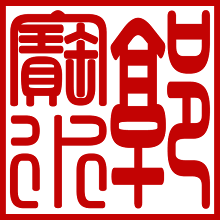“是”word is to make some verbs judgement,“是”work at the sentence predicate, the
main is to indicate a judgment. The judge is to explain that some object is
equal to what and belong to what.
Kata “是” itu utk memutuskan sebuah kata
kerja, “是”berfungsi sebagai predikan
dan tujuan utamanya adalah utk memutuskan. Pemutusannya adalah utk menjelaskan
sebuah obyek sama dengan apa dan termasuk apa.
“是”字句是由判断动词,“是”做谓语构成的句子,主要表示判断。所谓判断是说明事物等于和属于什么。
Struktur dasar (basic
structure) 基本结构是:
Name (people or thing) + 是 + Name (people or thing)
Nama (orang atau benda) + 是 + Nama (orang atau benda)
名(人或事物)+ 是 + 名(人或事物)
(2)他是伟大的科学家。
(3)那本词典是我的。
(一) When the meaning is “equal
to”, the structural place of subject and object could be change.
Saat
artinya “sama dengan”, penempatan struktur subyek dan obyek bisa dibalik.
在意义上表示“等于”时,结构上主语和宾语的位置可以互换,例如:
(1)我是李娜 》》 李娜是我
(2)十月一日是国庆节 》》
国庆节是十月一日
To
indicate the meaning of “equal to” also have a relevance in mutual explanation
Utk menunjuk arti dari “sama
dengan” juga memiliki hubungan saling menjelaskan..
表示“等于”意义还有一种相互解释的关系:
(1)他来中国的目的是学习汉语 》》 学习汉语是他来中国的目的。
(二) when the meaning is “equal
to”, the structural place of subject and object couldn`t change.
Saat
artinya “termasuk”, penempatan struktur subyek dan obyek tidak boleh dibalik / ditukar.
在意义上表示“属于”时,结构上主语和宾语的位置不能互换。例如:
(1)我是这个公司的职员
》》 这个公司的职员是我(X)
(2)那本词典是我的
》》 我的是那本词典(X)
Sometimes “是” is the meaning judgment, also have a
meaning.
Kadang “是” adalah utk memutuskan arti, dan juga
mengandung arti.
“是”有时候判断意义,又存在意义。
Struktur
dasar (basic structure) 基本结构是:
Premises word + 是 + Name (people or thing)
Kata tempat + 是 + Nama (orang atau benda)
处所词语 + 是 + 名(人或事物)
例如:(1)图书馆的旁边是一片小树林。
(2)火车站前是一个宽阔的广场。
(三) when “是” become predicate and contain “existence”,
commonly the subject is indicate some place,can`t
change the subject and object.
Saat “是” menjadi predikat dan mengandung arti
“adanya”, pada umumnya subyek adalah suatu tempat, subyek dan obyek tidak boleh
ditukar.
含“存在”意义的“是”作谓语时,主语一般是表示方位或场所意义的词语,主语跟宾语不能换位。
(1)一个宽阔的广场是火车站前(X)
(2)一片小树林是图书馆的旁边(X)
Beside the explain relevance, the word that related
with “是” is noun.
Selain penjelasan hubungan, yang berhubungan dengan “是” adalah kata benda.
除解释关系外,“是”联系的词语应该具有名词性。
例如:(1)今天是开学的第一天。
(2)我们是参观工厂的,他们是参观农村的。
(3)我们是参观工厂,他们是参观农村。(X)
(四) when
“是” only indicate a judgment,
existence, and not indicate an action, we can`t add “着” “过” and indicate finish of “了” at behind. We can add some word that
indicate time in the front of verbs if it was the past.
Saat “是” hanya menunjuk pemutusan, adanya dan
tidak menunjuk tindakan, kita tidak boleh menambahkan “着” “过” dan yg menunjuk selesai “了” dibelakangnya. Kita boleh
menambahkan kata waktu didepan kata kerja jika menunjuk keadaan lampau.
“是”只是表示判断、存在、不表示动作,后边不能加“着” “过” 和表示完成意义的“了”。如果表示过去的情况,可以在动词前边加上表示时间意义的词语。
例如:(1)这所房子以前是他的。
(2)那时,他只是农民。
(3)十年前,这里曾经是一片沼泽。
But,
usually will add “了”,if “是” word is judge some people or some
object and bring up some condition.
Tetapi,
saat kata “是” memutuskan seseorang atau
obyek, pada umumnya akan ditambahkan “了”
dibagian belakang.
但是,“是”字句也可以判断某个人或事物出现了某种情况,这时句尾常常加“了”
例如:(1)把钥匙那去吧,这个房间时你的了。
(2)从此,你不再是我的朋友了。
(五) Negative model of“是”word. Only can use “不” to deny, can`t use “没” or “没有”.
Bentuk negative
dari kata “是”. Hanya boleh menggunakan “不” utk menyangkal, tidak boleh
menggunakan “没” atau “没有”.
“是”字句的否定形式。只能用“不”否定,不能用“没”或者“没有”。
例如:(1)我说的那个人不是他。
(2)我说的那个人没是他。(X)
(六) question model of “是”.
Bentuk kata
Tanya dengan “是”
“是”字句的疑问形式。
A:是。。。。。。。吗?
这房间是你的吗?
B:是不是。。。。。。?
他是不是你的女朋友?
C:是。。。。。。不(是)?
车站旁边那个楼是邮电局不(是)?
When use
as negative word, sometimes we don`t need to write “是”
Terkadang tidak
perlu menulis “是” saat menjadi kalimat
negatif
否定部分的“是”,有时候可以省略。
We can`t add
a question word “吗”if the question is “是不是” or “是。。。不(是)”
Saat bertanya
menggunakan “是不是” atau “是。。。不是”,tidak boleh menambahkan kata Tanya “吗”.
用“是不是”或“是。。。不是”疑问时,句后一定不能在加表示疑问语气的“吗”。
例如:(1)他是不是参加会议的代表吗?(X)
(2)那把雨伞是你的不是吗?(X)
Furthermore,
“是” always use with
noun, verb, adjective and the other phrase with “的” component, it indicate various meaning judgement.

No comments:
Post a Comment
Just feel free to comment or ask anything my friend.
help us to improve this blog for the benefit of anyone who want to learn Chinese.
i`ll always try the best to answer or reply your comment as soon as possible ^.^